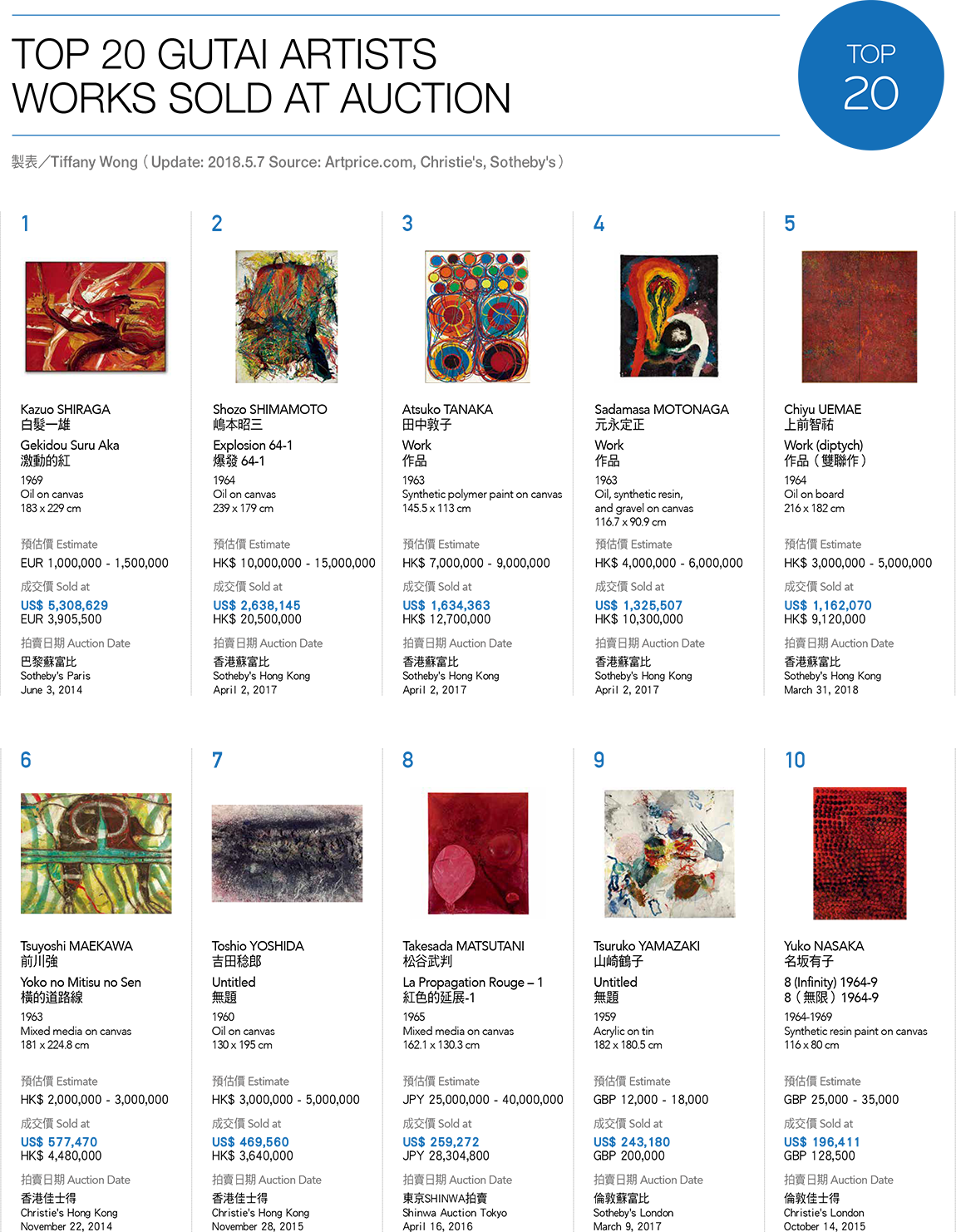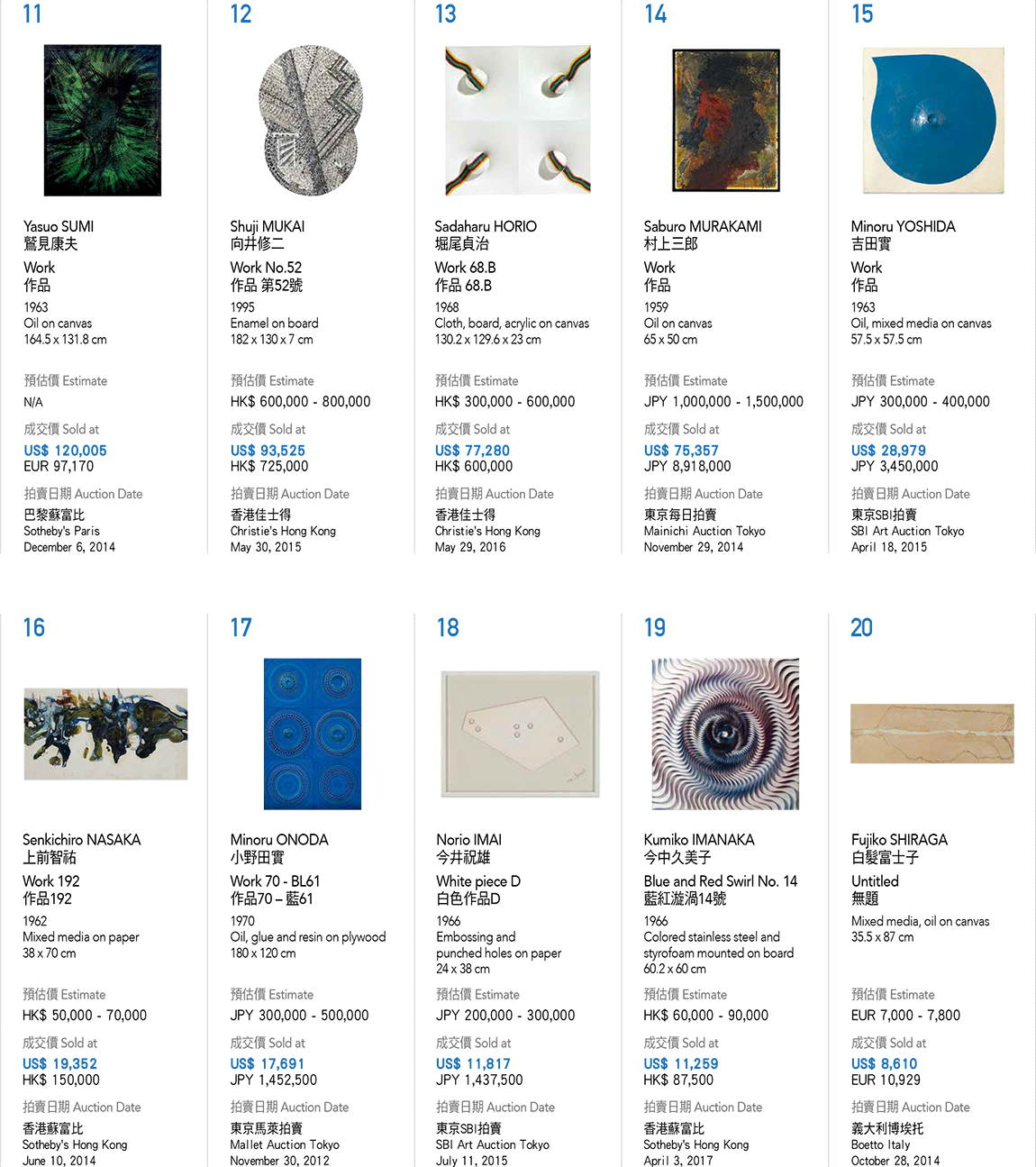Art Column
Post-War Abstract Art and the Rise of Gutai
Odile Chen / Ravenel Quarterly No. 25 Summer 2018 / 2018-05-16
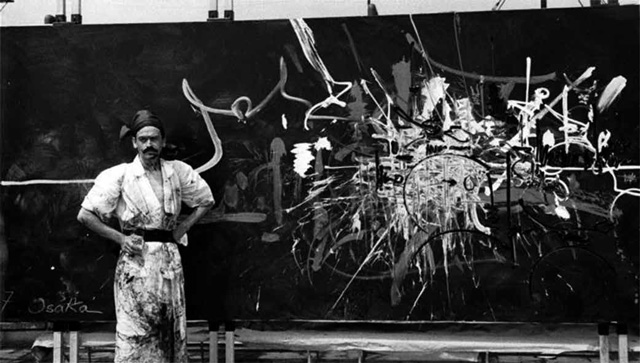
The art market is a stage for an array of competitive strategies. There is never a shortage of lead actors or stars, and aside from the artists themselves, of course, the spotlight is focused on their works as the object of everyone’s attention. Because of generational differences and changes in tastes, artists of different periods or schools from time to time may get some ink in the newspaper. Some of these artists will produce works that become enduring classics, while newcomers will flourish or perish along with the economic fates of their homelands, the wheels of fortune ever turning, “out with the old, in with the new” being a common plight. The artists and their schools, whether avant-garde or classical, abstract or realism, pop art or street art, each have every opportunity to sit upon the sky-high throne. Some deals have taken place through private arrangements, some through auctions. We can see that Da Vinci, Picasso, Modigliani, Gauguin, Basquiat, Pollock, De Kooning or Rothko are on hot search lists in the art market this past year or two.
POST-WAR ABSTRACT ART LEADS THE MARKET
In mentioning schools and genres competing for recommendation at current art exhibitions and auctions, Post-War Abstract Art is without a doubt one of the leaders of the sky-high prices in the market. This includes Cy Twombly, master of the New York school, as well as masters of Europe’s Lyrical Abstraction movement who raced to refresh their private purchase and auction records. In the spring and fall of 2017, the abstract paintings of Chinese master Zao Wou-Ki consecutively beat personal auction records. Willem de Kooning’s abstract painting “Untitled” sold for USD 35 million at Hong Kong’s Art Basel in the spring of 2017, setting a new high mark for Art HK events. He also holds the record for the highest auction price at USD 300 million.
Art is the mirror of history, reflecting the thinking of artists as they faced the changes of their times, thus it is a microcosm of each era. Fauvism and Cubism at the opening of the 20th century inspired artists to focus on the composition of form and color. Kandinsky discovered the essence of this as he completed his first abstract watercolor in 1910. Following on the rapid development of industry, technology and modern architecture, the old concept of imitating nature was abandoned, becoming generalized and simplified with a sense of speed to become abstract art. The growth of nationalism on the heels of the industrial revolution led to war, and the consecutive world wars ruthlessly destroyed the beautiful cultural traditions of Europe. For both political and economic reasons, the focus of development of the arts moved from Europe to the United States following the Second World War.

The United States was called the melting pot of peoples, where after the Second World War, the arts cast off the shackles of tradition, resulting in the flourishing of a rich variety of forms. These forms included Abstract Expressionism and Pop Art which enjoyed the greatest reach and influence in American history, and whose influence persists today. The term “abstract expressionism” appeared in 1946 and was used in the New York art scene for 20 years. The movement traces its influences to abstract art and the Expressionists.Avant-garde abstract expressionism emerged in the United States and was influenced by Surrealism in Europe, oriental texts and calligraphy. Rapid development ensued with the avant-garde art movement being promoted in different places, such as Europe’s Lyrical Abstraction movement, The Fifth Moon Group on Taiwan in East Asia, Japan’s Gutai group, and Korea’s Monochrome painting (Dansaekhwa).
Over the past few years, international attention has focused on the scope and influence of abstract expressionism on post-war abstract art. Deserving of particular mention is a group of artists emerging from the Japanese Gutai Art Association in the mid 1950’s whose artist members gained recognition and praise from both academia and the markets. The reach of the Gutai artists was not only regional but also international. The phenomenon ignited at the 2013 Paris spring auction with the auctioning of a collection by Parisian dealer Rodolphe Stadler and included works by well-know European painters and Gutai artists. The phenomenon spread to Asia where auction records continue to be broken five years later. The Gutai abstract painter Kazuo Shiraga’s 1961work "Gekidou Suru Aka" surpassed its valuation nearly three-fold at 3.9m EUR (5.32m USD) setting a new personal record.
 In autumn 2015 during an evening auction event in Hong Kong focusing on the works of the Gutai founder Jiro Yoshihara, all pieces were sold in 100% white glove deals. This achievement will undoubtedly push the market fever for Gutai art to its peak. Recently, Gutai artists’ exhibitions or special showings are already being regularly included in mainstream auction events. This wave of competing lists of artists has had an effect on the galleries. Starting with the White Stone Gallery and Sakurado Fine Arts in Japan, De Sarthe Gallery in Hong Kong, Lin & Lin Gallery and Aki Gallery in Taipei, Fergus McCaffrey in Tokyo and New York, and Hauser & Wirth in Zurich, these major galleries have rolled out their exhibitions of related artists and their works one after another. All this activity has led to “Gutai Art Association” artists or just “Gutai” artists, in addition to highly popular Japanese artists Yayoi Kusama, Yoshitomo Nara and Takashi Murakami, being sought out by collectors and individuals in the worldwide art market.
In autumn 2015 during an evening auction event in Hong Kong focusing on the works of the Gutai founder Jiro Yoshihara, all pieces were sold in 100% white glove deals. This achievement will undoubtedly push the market fever for Gutai art to its peak. Recently, Gutai artists’ exhibitions or special showings are already being regularly included in mainstream auction events. This wave of competing lists of artists has had an effect on the galleries. Starting with the White Stone Gallery and Sakurado Fine Arts in Japan, De Sarthe Gallery in Hong Kong, Lin & Lin Gallery and Aki Gallery in Taipei, Fergus McCaffrey in Tokyo and New York, and Hauser & Wirth in Zurich, these major galleries have rolled out their exhibitions of related artists and their works one after another. All this activity has led to “Gutai Art Association” artists or just “Gutai” artists, in addition to highly popular Japanese artists Yayoi Kusama, Yoshitomo Nara and Takashi Murakami, being sought out by collectors and individuals in the worldwide art market.The chain of events is not accidental. With the support and promotion of academia, an art group from the last half of 20th century which had been neglected for decades was rediscovered by art critics and curators. A series of important exhibits, including the 2008 Venice Biennale displayed Gutai works. In 2012, the National Art Center, Tokyo exhibited “Gutai: The Spirit of an Era” - 18 years of Japanese avant-garde. The most critical exhibit was “Gutai: Splendid Playground” in 2013 at the Guggenheim Museum in New York. In 2014, Japan’s Karuizawa New Art Museum hosted a series of exhibitions: “Gutai-jin in Karuizawa”. The Ayala Museum in Manila exhibited 80 Gutai sculptures and paintings in their exhibit: “A Taste of Gutai: Lito and Kim Camacho Collection”. With the endorsement of the Biennale and museum organizations, curators succeeded in reviving an avant-garde art school which had been overlooked.
"Gutai, it was as if we met with a life form from Mars."
Twenty years of economic collapse, followed by the great earthquake tsunami and nuclear disaster, have taken their toll on the nation’s self confidence. If Japan’s contemporary artists are recognized overseas, rekindling trade in the modern art market, perhaps this will help to heal the Japanese people and, in turn, strengthen the art market. Reviving Gutai, we see that Japanese artists are mingling again with the international community. The works of Japanese artists can increasingly be found in art auction markets around the world and Japanese art dealers are gradually being found among them.
The Japanese people are rigorous in their nature and respect professionalism. After their defeat in the Second World War, people with aspirations in the art community wanted nothing to do with the old system. Neither did they want to blindly follow in the footsteps of Europe and America, but aspired rather to establish their own style of art. Looking back to the origins of the Gutai, in 1950s Osaka, Japan, the key figure was Jiro Yoshihara(1905-1972). He was inspired by Tsuguharu Foujita of the Parisian school. Appreciating the principle of originality, Jiro seemed a promising artist in 1930’s Japan. In his early career he focused his studies on surrealism and abstract expressionism. Later he established the Gutai group and under his leadership created an exhibition along with 16 young students. Jiro Yoshihara’s directive was that members take the path not taken by anyone else, to create unprecedented artistic innovation.

The name “Gutai” was coined by Shozo Shimamoto, one of the group's members. “Gutai” is composed of “Gu” meaning “tool” and “tai” meaning “body” - together meaning “using tools and the body.” Members abandoned the use of the traditional tools of artists, especially brushes, rather boldly expressing themselves in different ways, especially using their bodies. The art critic Ichiro Haiu attending an exhibit of Gutai art in 1955 exclaimed: “It was as if we met with a life form from Mars” expressing his amazement for something never seen before. Each member of the group expressed themselves artistically in uniquely individual ways. Shozo Shimamoto threw glass bottles filled with colored ink at canvases to create “bottle crash paintings.” Sadamasa Motonaga used plastic tubes filled with pigment, allowing them to drip and splash out paint to achieve his creative technique. Michio Yoshiwara left the imprint of bicycle tires on his canvas. Yasuo Sumi used vibrating devices, passing paint through rotating abacus rollers and paper umbrellas to achieve a rotating effect.Atsuko Tanaka wore “electric clothing” - a dress of innumerable flashing lights.Saburo Murakami used his body to break through upright paper doors.
With unprecedented application of various media, creativity and vitality the artists’ directions included performance art, happening art, installation art, technology art, sound art, interactive art, land art, light art, conceptual art, etc.Gutai arrived in the United States in 1958 for their first overseas exhibit at the Martha Jackson Gallery in New York, however they were ruthlessly attacked by critics in an editorial in the New York Times, describing them simply as an offshoot of Abstract Expressionists, and failing to see their spirit of avant-garde creativity.
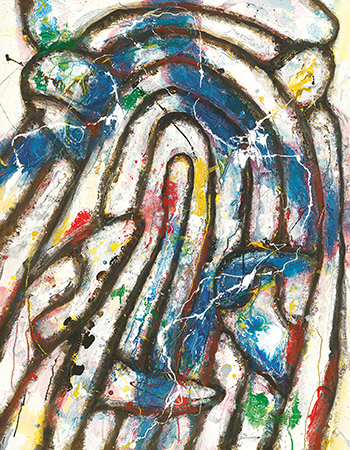 The Gutai art movement developed over a period of 18 years, from the group's founding in 1954 until the death of its founder Jiro Yoshihara in 1972. The development primarily took place in two phases: the first from 1954 to 1962 and the second from 1962 to 1972. The second phase includes the First Gutai period and the Second Gutai period. In addition to the founder, Jiro Yoshihara, the core artists of the First Period were: Shozo Shimamoto (1928- 2013), Kazuo Shiraga (1924-2008), Fujiko Shiraga (1928–2015), Yasuo Sumi (1925-2015), Sadamasa Motonaga (1922-2011), Akira Kanayama (1924-2006), Atsuko Tanaka (1932-2005) and Chiyu Uemae (1920- ). In 1962 the addition of new young artists sparked the innovative energy of the Second Gutai period. These artists experimented with new materials and the Gutai art reached its peak of development. New artists appearing in the Second Gutai period included Tsuyoshi Maekawa (1936- ), Sadaharu Horio (1939- ), Takesada Matsutani (1937- ), Yuko Nasaka (1938- ), Tsuruko Yamazaki (1929- ), Shuji Mukai (1940- ) and Yutaka Matsuda (1942-1998). Altogether, nearly 60 artists were members in the group of the entire Gutai period.
The Gutai art movement developed over a period of 18 years, from the group's founding in 1954 until the death of its founder Jiro Yoshihara in 1972. The development primarily took place in two phases: the first from 1954 to 1962 and the second from 1962 to 1972. The second phase includes the First Gutai period and the Second Gutai period. In addition to the founder, Jiro Yoshihara, the core artists of the First Period were: Shozo Shimamoto (1928- 2013), Kazuo Shiraga (1924-2008), Fujiko Shiraga (1928–2015), Yasuo Sumi (1925-2015), Sadamasa Motonaga (1922-2011), Akira Kanayama (1924-2006), Atsuko Tanaka (1932-2005) and Chiyu Uemae (1920- ). In 1962 the addition of new young artists sparked the innovative energy of the Second Gutai period. These artists experimented with new materials and the Gutai art reached its peak of development. New artists appearing in the Second Gutai period included Tsuyoshi Maekawa (1936- ), Sadaharu Horio (1939- ), Takesada Matsutani (1937- ), Yuko Nasaka (1938- ), Tsuruko Yamazaki (1929- ), Shuji Mukai (1940- ) and Yutaka Matsuda (1942-1998). Altogether, nearly 60 artists were members in the group of the entire Gutai period.EAST-WEST EXCHANGES BETWEEN AVANT-GARDE MASTER PAINTERS
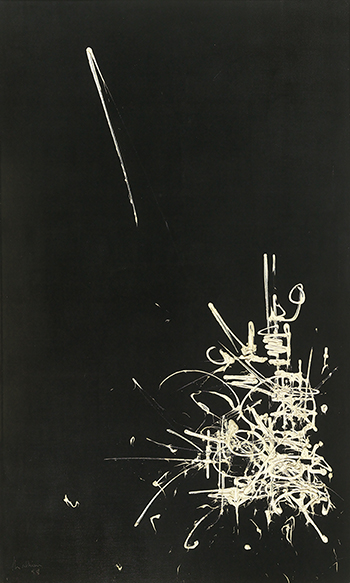 After World War II, not only was avant-garde art in the Americas and in Asia flourishing, the European art scene was also undergoing major upheaval.French art critic Michel Tapié, who heavily promoted the French Art Informel, regularly traveled to and from New York and encouraged cultural exchanges, introducing European artists such as Georges Mathieu and Jean Fautrier to the United States and Jackson Pollock to European circles. Interaction between Jiro Yoshihara and Japanese avant-garde painting and calligraphy groups was frequent and it was through the publications of these groups that allowed him to see the latest works by his counterparts in Europe and the United States. Jiro Yoshihara, passionate about connecting with the international scene, began publishing the bilingual magazine “Gutai” in 1955. Later a French version was also published, a testament to Yoshihara’s dedication.
After World War II, not only was avant-garde art in the Americas and in Asia flourishing, the European art scene was also undergoing major upheaval.French art critic Michel Tapié, who heavily promoted the French Art Informel, regularly traveled to and from New York and encouraged cultural exchanges, introducing European artists such as Georges Mathieu and Jean Fautrier to the United States and Jackson Pollock to European circles. Interaction between Jiro Yoshihara and Japanese avant-garde painting and calligraphy groups was frequent and it was through the publications of these groups that allowed him to see the latest works by his counterparts in Europe and the United States. Jiro Yoshihara, passionate about connecting with the international scene, began publishing the bilingual magazine “Gutai” in 1955. Later a French version was also published, a testament to Yoshihara’s dedication.Michel Tapié visited Japan in 1957. Not satisfied with the geometric compositions in abstract art, he found a perfect match in the Japanese Gutai’s rejection of abstract painting. Tapié thus introduced Gutai art to the West, becoming an important channel for learning about Gutai in the European art world. And even though Gutai artists rejected abstract art, Yoshihara, as a teacher of avant-garde art, held in high esteem European and American artists and had great respect for abstract expressionist masters Georges Mathieu and Jackson Pollock, praising their work for breaking free of traditional rules and providing inspiration for Gutai artists’ works. Mathieu and Pollock were representative of the European and American abstract expressionism movement and both of the artists were core figures that enjoyed a high level of success.The Gutai school was dedicated to exploring new media and totally new forms of expression in painting, which, like the exploration of the artists of abstract expressionism, was significant for the times.
Because Tapié was visiting Japan at the invitation of Imai Toshimitsu, an Informel artist of Japanese descent, accompanying him were Georges Mathieu, Jackson Pollock and Sam Francis. Georges Mathieu, wearing a Japanese kimono, painted one of his works on the roof of a department store in Osaka. Georges Mathieu’s art was also the inspiration for Allan Kaprow’s “Art Happenings” and Yves Klein’s “Anthropometry” series in 1957.
This trip set off new trends in Japan and is a profoundly significant event in setting into motion exchanges between the European Art Informel and Japanese Gutai artists. It was also important factor in allowing Gutai artists access to the international stage. Actually, Gutai artists also influenced art trends thereafter, including Korean materialism works and highly experimental artists of the Fluxus school, such as John Cage, Joseph Beuys and Yoko Ono. At the time, Kazuo Shiraga’s work done with his feet appeared a few years before that of the well known Yves Klein. Because Klein had been working on painting in Japan at the time, it is assumed that he was influenced by Kazuo Shiraga’s work. Nevertheless, it is clear that Gutai art has earned a clear place in the history of contemporary Asian art.
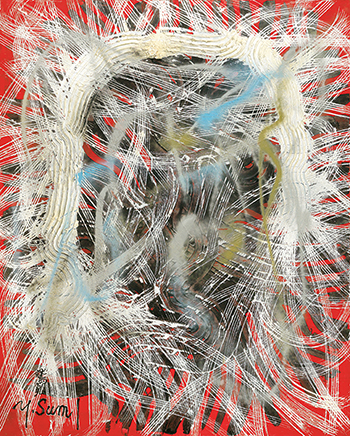 Michel Tapié introduced Gutai art to Europe and succeeded in a small number of works finding favor with French collectors. However, it never completely drew the attention of Western collectors. Before 2000, auction price sentiment rarely surpassed the USD 50,000 level. Following the 2013 exhibition at the Guggenheim Museum in New York, though, auctions for works by Gutai artists have sparked the interest of collectors worldwide, particularly that of major collectors who have already collected New York abstract expressionist art. The market price for Kazuo Shiraga’s work has been the highest for works by Gutai artists. His work was also the first to see the rise in market price, particularly since his passing in 2008. Shiraga’s Gutai period works as well as works from his later period hit new highs, reaching the highest recorded price of USD 5,317,338 (€ 3,905,500 or approximately TWD 150 million). Other works surpassing the USD 1.0 million mark include that of Shozo Shimamoto at USD 2,635,298 (HKD 20.5 million or approximately TWD 49.0 million), that of Chiyu Uemae at USD 1,162,178 (HKD 9.12 million or approximately TWD 31.48 million), and so forth. The greatest number of transactions has been for works of Kazuo Shiraga and Sadamasa Motonaga. Gradually, we have also seen the works of other Gutai artists such as Tsuyoshi Maekawa, Yasuo Sumi, Takesada Matsutani and Jiro Yoshihara gain traction in the market with valuations continuing to be undervalued and are still being closely watched by collectors everywhere.
Michel Tapié introduced Gutai art to Europe and succeeded in a small number of works finding favor with French collectors. However, it never completely drew the attention of Western collectors. Before 2000, auction price sentiment rarely surpassed the USD 50,000 level. Following the 2013 exhibition at the Guggenheim Museum in New York, though, auctions for works by Gutai artists have sparked the interest of collectors worldwide, particularly that of major collectors who have already collected New York abstract expressionist art. The market price for Kazuo Shiraga’s work has been the highest for works by Gutai artists. His work was also the first to see the rise in market price, particularly since his passing in 2008. Shiraga’s Gutai period works as well as works from his later period hit new highs, reaching the highest recorded price of USD 5,317,338 (€ 3,905,500 or approximately TWD 150 million). Other works surpassing the USD 1.0 million mark include that of Shozo Shimamoto at USD 2,635,298 (HKD 20.5 million or approximately TWD 49.0 million), that of Chiyu Uemae at USD 1,162,178 (HKD 9.12 million or approximately TWD 31.48 million), and so forth. The greatest number of transactions has been for works of Kazuo Shiraga and Sadamasa Motonaga. Gradually, we have also seen the works of other Gutai artists such as Tsuyoshi Maekawa, Yasuo Sumi, Takesada Matsutani and Jiro Yoshihara gain traction in the market with valuations continuing to be undervalued and are still being closely watched by collectors everywhere.The rebounding of the Japanese art market coupled with the depreciation of the Japanese yen has greatly raised the interest of international collectors in Japanese Gutai artists. According to a Artnet report, the Belgian art dealer Boris Vervoordt is an important player in the Gutai Art Association works. He leads Axel Vervoordt’s Art & Antiques, Gallery, Interior Design and Home Collection activities and has been a big promoter of Kazuo Shiraga’s works. But now the barrier to entry for procuring Kazuo Shiraga’s works is becoming more challenging with prices increasing beyond the reach of most would-be collectors. Conversely, art dealers and collectors are seeking out the works of post-war Japanase abstract artists, especially the works of other prominent Gutai artists. As amassing collections of the classic contemporary masters proves increasingly difficult, art dealers are once again reassessing the post-war contemporary art market, focusing on groups of artists from the same period as the abstract expressionists, such as the Gutai artists and their works, the value of which is poised for growth.
Many internationally acclaimed art galleries dealing in contemporary art have continuously invested in promoting Gutai artworks and related artists have already become regulars at international auction events. Five years later, although the market has become more rational, the prices for the works from undervalued artists are likely to increase.
